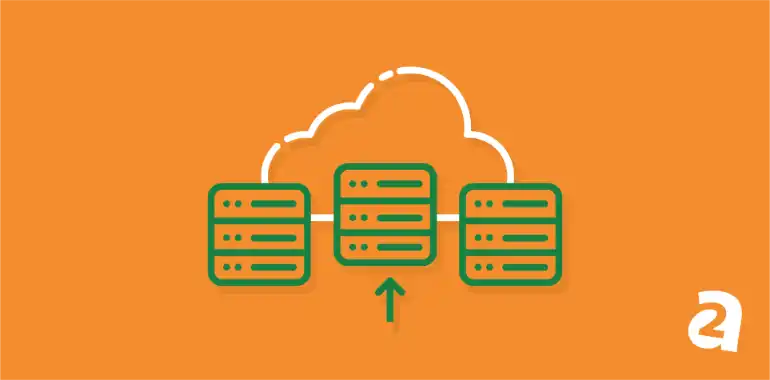- Feb 24, 2021
 0
0- by A2 Marketing Team
There are a lot of fantastic cloud storage solutions for businesses of every size. Storing files on the cloud has never been easier or cheaper. However, there are a lot of advantages to using a private cloud storage solution over a ‘regular’ service.
With private cloud storage, you have full control over who can access your files and internal policies. Moreover, you can configure and secure a private cloud storage solution in practically any way you see fit.
In this article, we’ll dig deeper into the benefits of private cloud storage. Then we’ll show you how to setup private cloud storage for your business using Webuzo and Nextcloud. Let’s get to it!
Why Your Business Needs Private Cloud Storage
There are plenty of cloud storage solutions that you can use both privately and for your business. Many of these are remarkably easy to set up and cheap, to boot. However, there are downsides to using solutions such as Dropbox and Google Drive, just to name two examples.
With a third-party cloud storage platform, you’re never in full control of your files. When you sign up for any such platform, you sign terms of use, which outline what you can and can’t do or use their services for.
If you feel that your cloud storage provider doesn’t provide you with enough safety measures, there’s little you can do about it. With a private cloud solution, on the other hand, you can configure your storage just the way that you want it.
Moreover, using a private solution, you’re never at the mercy of a service provider who can decide when to terminate your account or delete files in storage.
The main reason why more businesses don’t use private cloud storage is that third-party platforms tend to be much easier to set up. With solutions such as Dropbox, you only have to pay for a subscription, and hand over the setup and maintenance.
However, managing and configuring a private server is not as complex as you might imagine. Even if you have limited system administration experience, most web hosts provide you with plenty of tools that make using Virtual Private Servers (VPS) remarkably simple.
Why Use a VPS to Setup Private Cloud Storage
Technically, you can use any server to setup private cloud storage for your business. However, a VPS is the perfect solution when it comes to file storage. Let’s break down why this is:
- A VPS is scalable. You can easily set up a cloud storage solution using a VPS and scale it as your needs grow.
- The solution can be cheap. Depending on what type of VPS plan you choose, they can be much cheaper than other types of hosting and cloud storage solutions.
- You’re in full control of every setting. With a VPS, you can set up your server configuration and cloud storage solution just the way that you want it to.
- You get to choose a cloud storage solution. There are several software options that you can choose from to help you set up private cloud storage for your business.
In our opinion, the ideal setup for private cloud storage involves an unmanaged VPS and open-source software. Using open-source cloud storage software means you can configure it to your exact requirements.
Unlike paid storage software solutions, open-source options won’t limit the number of users that have access to your cloud. As for unmanaged VPSs, they tend to be comparably cheaper than their managed counterparts.
The ‘downside’ to using an unmanaged VPS is that you need some experience when it comes to system administration. Alternatively, you can simply follow a thorough tutorial that teaches you how to setup private cloud storage on your server. That’s precisely what we’ll do in the next section.
How to Set Private Cloud Storage for Your Business (6 Steps)
In this section, we’ll guide you from choosing a VPS plan to setting up open-source cloud storage software and configuring it. Let’s get to it.
Step 1: Select a VPS Plan
Which hosting provider to choose is up to you but we recommend A2 Hosting’s unmanaged VPS plans. Using A2 Hosting, you get unmanaged VPS options starting at $4.99 per month for 150 GB of SSD storage:
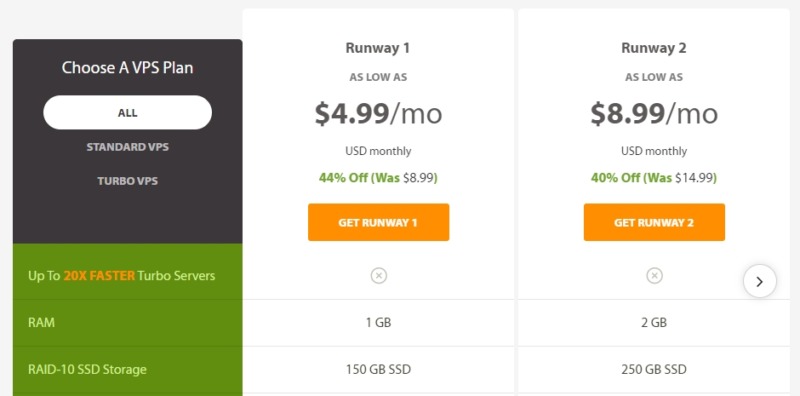
Although 150 GB might not be enough for enterprise-level storage, it’s a decent start for a small business. When setting up private cloud storage for the first time, it’s a good idea use a cheap VPS.
The great thing about a VPS is that you usually can scale resources as needed, which A2 Hosting enables you to do. As your cloud storage needs grow, you can always upgrade to a better plan.
The instructions you’ll see throughout the rest of this tutorial apply regardless of which web host or VPS plan you use. However, you will need two things to follow along with this tutorial:
- Your VPS or regular server must use a recent version of CentOS, Red Hat Linux, Scientific Linux, or Ubuntu.
- You need access to the server’s terminal as well as administrative privileges.
A lot of the instructions involve the use of the command line, which means you need to use a server you have full access to (i.e. shared hosting won’t cut it).
Step 2: Connect to Your VPS Via Secure Shell (SSH)
Since we’re using a VPS, you’ll need to connect to it via SSH to use the command line. Connecting to a VPS via SSH is relatively simple.
If you’re using a UNIX-based operating system, you can connect to your VPS using SSH via the command line. For Windows, you’ll need to use software such as PuTTy, which enables you to establish SSH connections with remote servers.
To use PuTTy, setup, and start the software. Once you launch the application, you’ll see the option to enter a hostname and select the type of connection you want to establish:

Usually, when you spin up a VPS your web host will generate a root account and a password for it. You’ll also get a dedicated IP address, which you can use to connect to the VPS.
Enter your VPS’ IP address and select SSH under Connection type, then click on Open. PuTTy will launch a terminal window and ask you for a login username:

Type root and enter your root account’s password. Afterward, you’ll have full access to your server via SSH:

Now comes the fun part – configuring your private cloud!
Step 3: Setup Webuzo on Your VPS
At this stage, you have a VPS with a clean slate. Before we can install a cloud storage solution, we need to choose and set up a software ‘stack’.
We use the term ‘stack’ to refer to all of the software you use to power specific applications. One of the most common software stacks is called LAMP and it includes the following software:
- Apache. This is the web server component of the stack, which enables outside users to connect to your server.
- MySQL. With MySQL, other applications can store data on your server using a comprehensive database system.
- PHP. This programming language is the backbone of a lot of popular software.
You already have the L component of the stack, which is the Linux Operating System (OS). Now, we’re going to set up the rest using a solution called Webuzo.

With Webuzo, you can setup the full software stack and use Softaculous from within your VPS. If you haven’t used Softaculous before, it’s a solution that enables you to install hundreds of web applications on your server using a simple interface.
We’ll show you how that interface looks in a minute after we install Webuzo. To do so, return to the SSH terminal window you opened before and type the following commands:
wget -N http://files.webuzo.com/install.sh chmod 0755 install.sh ./install.sh
Those commands will install Webuzo alongside the rest of the LAMP software stack, as well as DNS and FTP servers. Installation can take a while and during that time, you might not see any changes or updates within your terminal:

That is normal, so be patient and wait until you see a message that tells you the installation is complete:
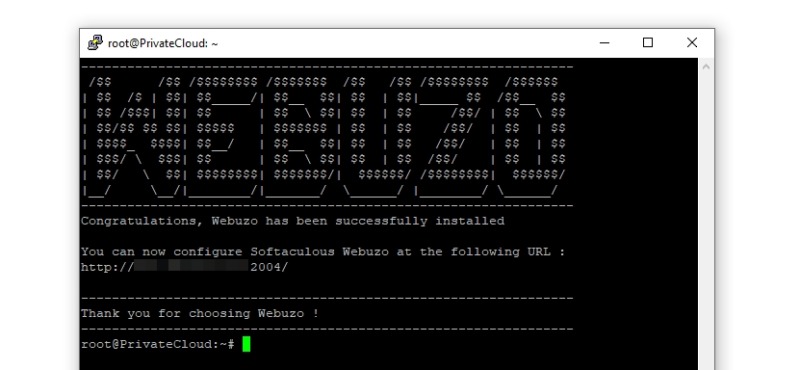
If you look closely, you’ll see the installer provides you with a direct URL for your Softaculous installation. Copy that URL and access it from a browser.
To finish the setup process, you need to fill out some additional information. including setting a username, password, email address, and entering your domain and nameservers:
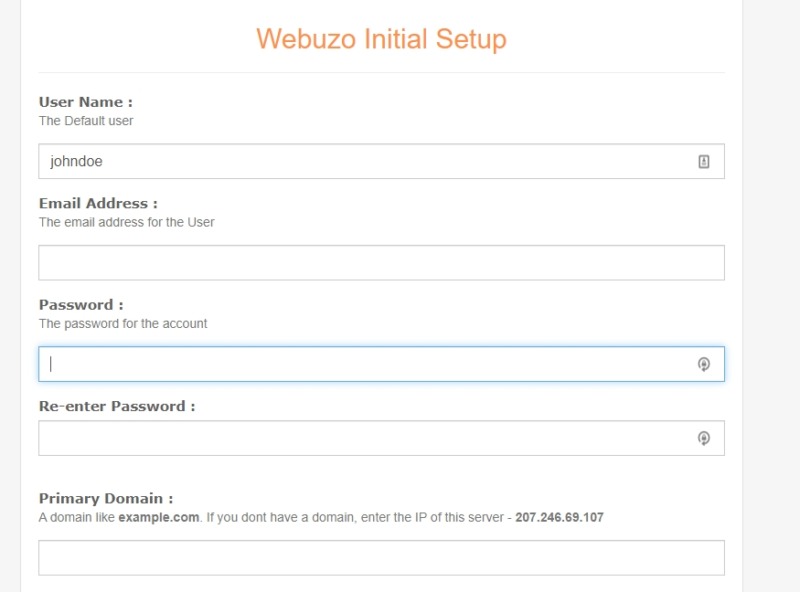
If you haven’t set up a domain for your private cloud storage VPS, don’t worry. You can go ahead and enter the IP address of your VPS and fill out the nameserver fields with dummy information. The software will still work even in that case.
Now you’ll need to wait while Webuzo finishes installing. Once it’s ready, Webuzo will share instructions on how to login to its admin panel and the Softaculous dashboard:
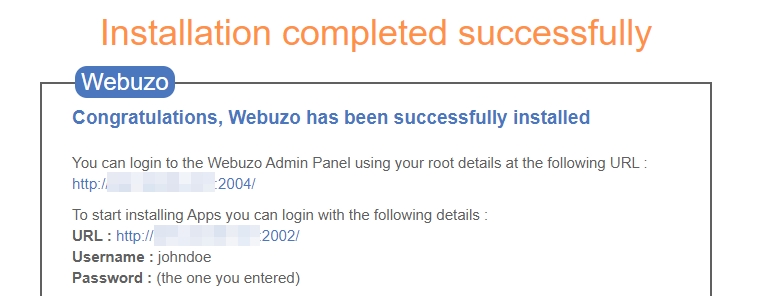
Go ahead and access the URL Webuzo indicates to start installing apps. In the next section, we’ll setup the private cloud storage solution you’ll be using.
Step 4: Install NextCloud
At this point, you should have access to an admin dashboard:
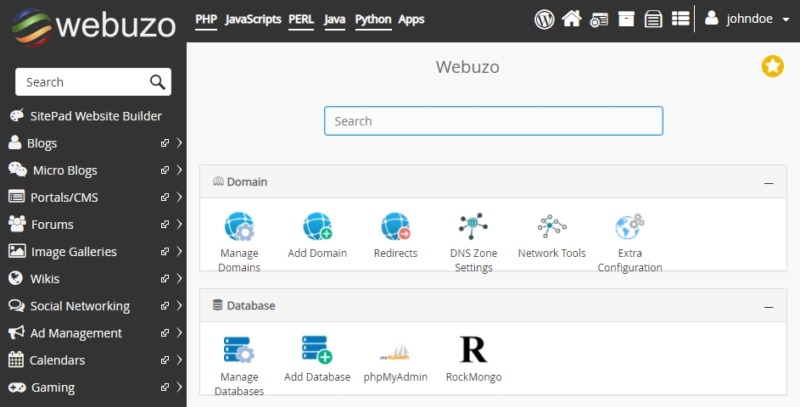
If you’ve used Softaculous before, this dashboard should be familiar. To the left, you have a list of app categories to choose from. Open the File Management subsection and select NextCloud.
NextCloud is an open-source file sync and storage solution that you can set up on your cloud. It’s a highly scalable application, which means that it works both as a private solution and for enterprises:
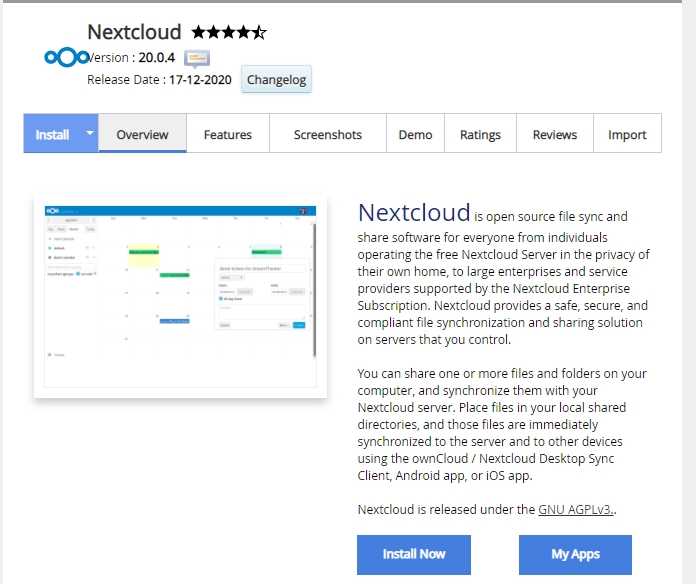
Using NextCloud, you can share and upload files from your computer to your cloud storage server. Other users can download the NextCloud app on their desktops or mobile devices to access those files as well.
That’s pretty much how most cloud storage solutions work. The difference is, you can use NextCloud for free, so let’s go ahead and install it.
Click on the Install Now button and Webuzo will ask you to enter an installation URL for NextCloud. You’ll also need to set up an admin username and password:
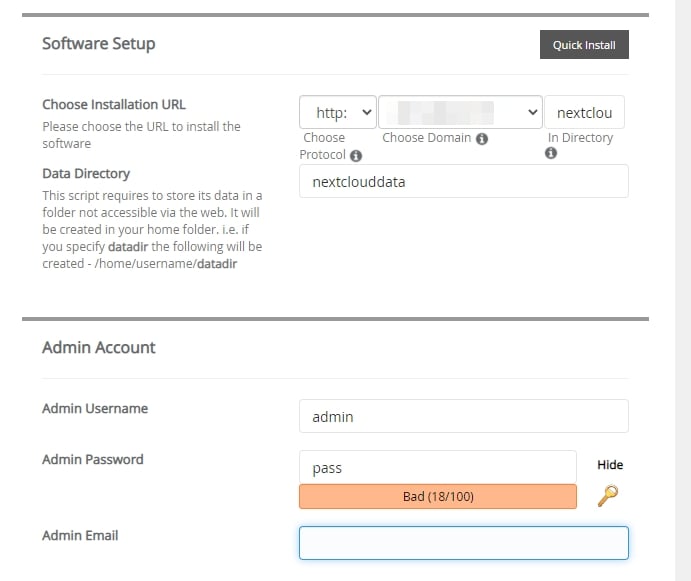
You can also select a different language for your Nextcloud setup. Once you fill out all the required fields, click on the Install button at the bottom of the page.
Once the installation is complete, Nextcloud will ‘launch’ on your browser and you’ll be able to login using the account you just created. That will give you access to the NextCloud dashboard:
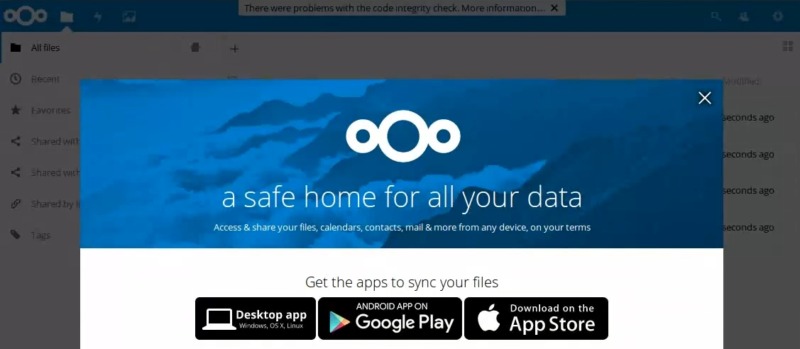
NextCloud will prompt you to download the applications that you can use to sync files from your computer or mobile devices with your cloud.
At this stage, you can go ahead and download the applications that you want to use. Once you download, install, and launch the NextCloud application, it’ll ask what server to connect to and request your user credentials:

The software will also ask what files and folders you want to sync to your cloud:
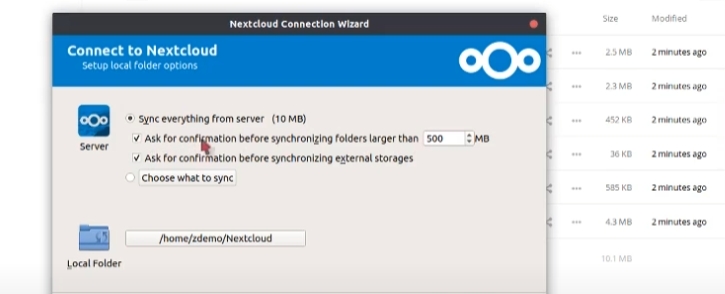
You can designate what folder NextCloud will sync those files to and once you do, you’re in business.
Step 5: Configure NextCloud
NextCloud provides you with a broad range of settings that you can use to configure your cloud. For starters, we recommend you take a look at your installation’s security, sharing, and encryption settings.
To do this, go to your account’s drop-down menu at the top-right corner of the screen and select Settings. From this screen, you’ll get access to all the options to configure NextCloud.
If you click on Monitoring, for example, you’ll see a full breakdown of server usage, active users, and more:
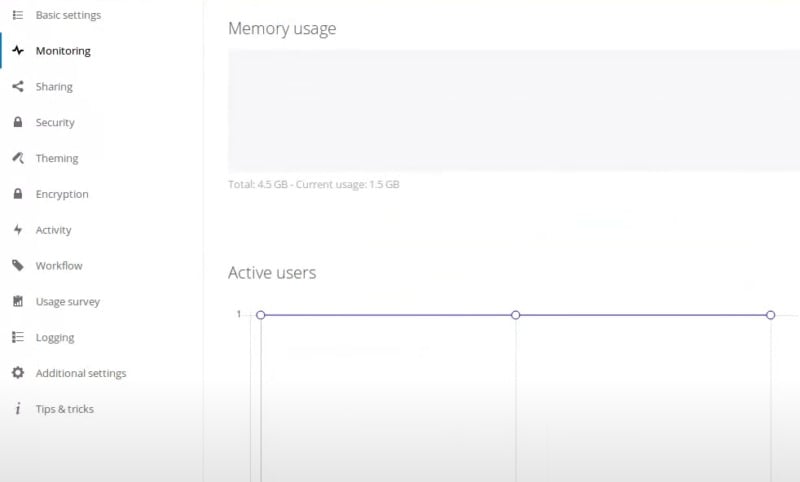
Under Sharing, you can configure whether users will be able to share files from the cloud. With NextCloud, you can share files publicly and make it so external parties need to enter a password to get access to them.
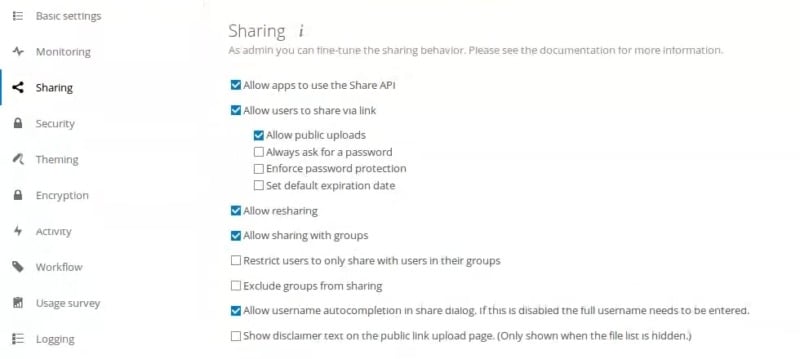
More advanced settings include the option for shared link expiration, sharing, excluding groups or users from sharing, and more.
Moving on to the Security settings, this section will enable you to set password policies, add clients that can get access to your cloud, and whitelist the IP addresses that can connect to it:
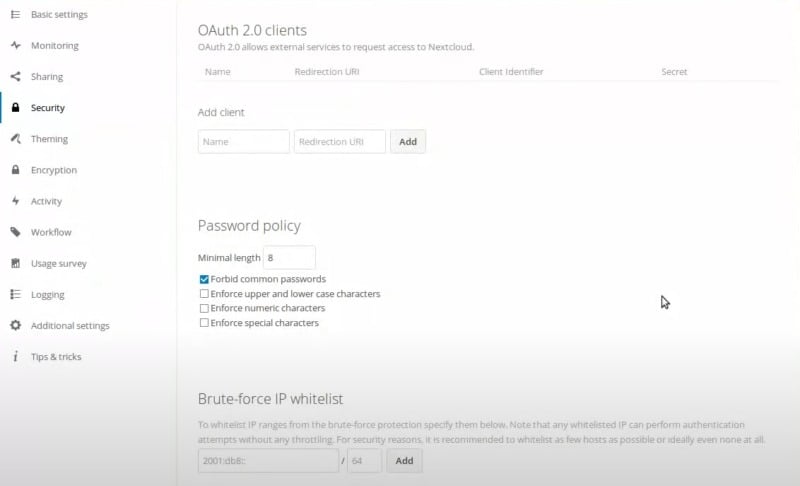
If you jump to the Encryption tab, you can (and should) enable server-side encryption by ticking a single box. Keep in mind that forcing server-side encryption might impact your server’s performance, but it’s well worth it to ensure the safety of your files.
Finally, if you move on to the Activity tab you can choose what events NextCloud will log for you:
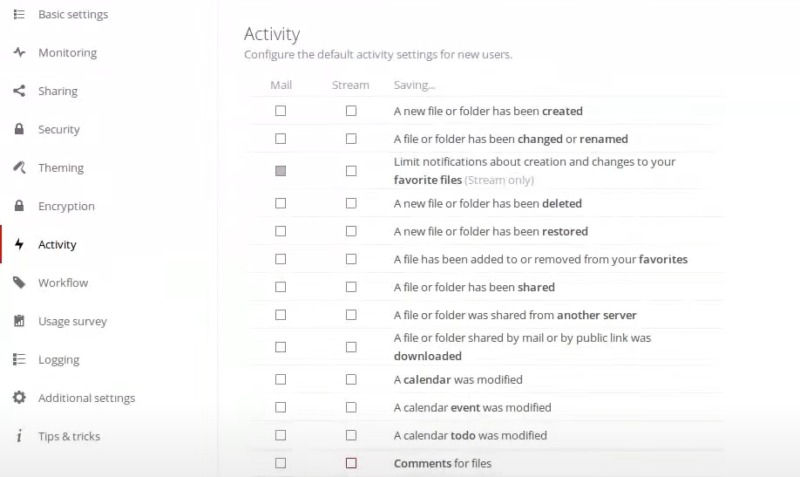
By default, NextCloud will log almost everything that happens on the application. If you want to keep a close eye on user activity, we recommend you enable most tracking options that you see here.
At this stage, your private cloud storage solution is almost ready. Now all that’s left is to start adding users.
Step 6: Add Users to NextCloud
Open your account’s options menu once more and this time, select the Users option. You’ll see a list of all the user accounts for your NextCloud installation. Right now, it should look something like this:

You can create new user accounts by using the menu at the top of the screen. Type a username, password, and assign a group if you’re using them (you can do this later as well).

NextCloud enables you to assign users to groups, give them admin privileges for specific groups, and even set individual file storage quotas.
After you create a user, you can share login details with your team members in any way that you see fit. They’ll be able to connect to NextCloud either through their browsers or any of the available apps.
Each user gets to decide which NextCloud app they want to use if they want to sync files locally. Keep in mind that users will need to connect to the server and enter their login information through each app to do so, which you might need to explain to them.
Conclusion
The idea of setting up a private cloud solution for your business might seem intimidating. However, the process is much simpler than you’d imagine. By combining a VPS with Webuzo, you can install cloud storage applications such as NextCloud in a matter of minutes.
Let’s recap the steps to setup a private cloud storage solution for your business:
- Select a VPS plan.
- Connect your VPS via SSH.
- Setup Webuzo on your VPS.
- Install NextCloud.
- Configure NextCloud.
- Add Users to NextCloud.
Do you have any questions about how to use NextCloud to setup private cloud storage for your business? Our team is waiting to answer them, and help you get setup with a private cloud storage solution!






